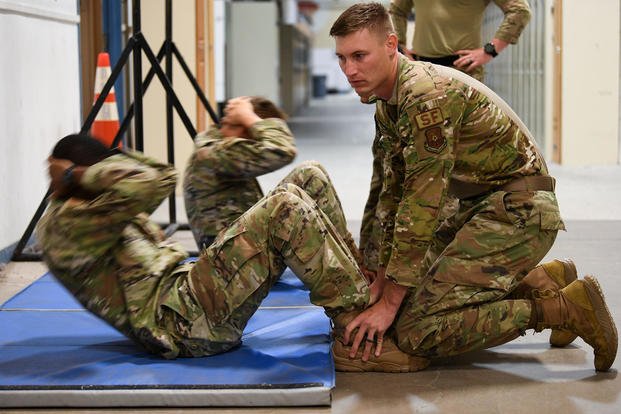The PT Progression Series is a series of answers about how to get better at pull-ups, push-ups and sit-ups for fitness testing, as well as boot camp and police or fire academies.
Part 1 of the PT Progression Series is the PT pyramid.
Someone asks about improving on fitness tests every day. Many people have issues with not just performing on an entry-level fitness test but also progressing in a manner that will enable them to perform well at boot camp or in police and fire academies. Here is an email from a concerned student who is preparing to join the military in the next year:
Stew, How do I get better at pull-ups, push-ups and sit-ups? I know I should do more of them, but how do I arrange workouts so I am going to see progress frequently (weekly/every other week)?
This is a great question, because we all have to start somewhere and then we progress into being PT animals eventually. The good news is that you have a year to train, but you need to start now. I am going to make my next several articles focus on the PT progression method. It all starts with building a foundation and then advances in the following workout arrangements.
PT Pyramid
Build a foundation with this workout, which has a warmup, max-out and cooldown all rolled into a single workout program. It is a great way to check progress as well. To get better at your specific PT test, build a PT pyramid like this:
- Set #1: One pull-up, two push-ups, five sit-ups ... (No rest. Your rest is the muscle-group rest you get by doing other exercises)
- Set #2: Two pull-ups, four push-ups, 10 sit-ups
- Set #3: Three pull-ups, six push-ups, 15 sit-ups ... and so on.
Continue up the pyramid until you fail. If you find that you cannot do any pull-ups, then resort to negatives or flexed arm hangs for the number of seconds instead of repetitions. If you fail at push-ups, resort to knee push-ups and keep moving with the workout.
When you fail, try to repeat in reverse order back to what you did during the first set.
One way to balance out your core is to replace sit-ups with a plank pose on the way down the pyramid or alternate each set and do the plank during even sets and sit-ups during odd sets.
The PT pyramid is what I call a foundation workout. It helps the user build a solid foundation of calisthenics and increases volume so you will improve your previous limits. Once you get to level 10 and back down to one again, you will have done 100 pull-ups, 200 push-ups and 500 sit-ups/core exercises. (250 sit-ups/ 250 seconds in plank pose). If you can get to this level, you are now in a position to progress to PT Progression #2 and #3.
Complete PT Progression Series
- PT Progression Series #1: PT Pyramids: Do this workout every other day. No workout is good to do daily for long periods of time. It is best to do this foundation workout only three days a week.
- PT Progression #2: Superset: This is another sub max-effort foundation workout to increase the volume of your PT exercises. It is recommended to add this type of workout and replace a pyramid workout once a week so you only total these upper-body workouts only three times a week. Learn how to design a superset effectively.
- PT Progression #3: Max-Rep Set Workout: Once you have mastered the PT pyramid and the superset and can handle workouts with a volume of 100 pull-ups and 200 push-ups, then it is time to test your newfound strength. This workout will increase your muscle stamina and endurance, which is really the goal of mastering PT tests. Find out how to push your numbers even higher.
- PT Progression #4: PT/Run Workout: You can make a pyramid out of this one or make it one tough superset, but each "rest" period between sets is a run of various distances. Learn the best way to add running to the next generation of progression.
- PT Progression #5: PT and Advanced Movements Workout: Add tougher exercises into your pyramids and supersets, such as burpees, push presses, bear crawls, etc.
Stew Smith is a former Navy SEAL and fitness author certified as a Strength and Conditioning Specialist (CSCS) with the National Strength and Conditioning Association. Visit his Fitness eBook store if you're looking to start a workout program to create a healthy lifestyle. Send your fitness questions to stew@stewsmith.com.
Want to Learn More About Military Life?
Whether you're thinking of joining the military, looking for fitness and basic training tips, or keeping up with military life and benefits, Military.com has you covered. Subscribe to Military.com to have military news, updates and resources delivered directly to your inbox.


















